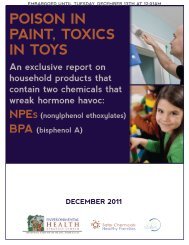POISON IN PAINT, TOXICS IN TOYS - HealthyStuff.org
POISON IN PAINT, TOXICS IN TOYS - HealthyStuff.org
POISON IN PAINT, TOXICS IN TOYS - HealthyStuff.org
Create successful ePaper yourself
Turn your PDF publications into a flip-book with our unique Google optimized e-Paper software.
(6) and one of each of the following products:<br />
disinfectant, drain treatment, sealant/�ller, surface<br />
care and protection, and spray foam insulation.<br />
Manufacturers also reported NPEs in personal care<br />
products, including eight brands of antiseptic iodine<br />
solution and six hair care products. Some products<br />
containing NPEs may be washed down the drain<br />
and into sensitive waterways from direct use (e.g. a<br />
drain cleaner), product disposal, or from rinsing and<br />
cleaning of brushes, rags or sponges under the faucet<br />
in the sink.<br />
4<br />
COMPANIES ARE SWITCH<strong>IN</strong>G<br />
TO SAFER SUBSTITUTES<br />
Some manufacturers are phasing out BPA and NPEs<br />
in products in favor of available alternatives that<br />
are presumably safer, e�ective and a�ordable. For<br />
example, the three infant formula makers that account<br />
for 98% of U.S. sales 9 reported that, as of October<br />
2011, they no longer sell baby formula in metal cans<br />
that contain BPA in the lining. Abbot Laboratories,<br />
MeadJohnson and Nestlé/Gerber all replaced BPA in<br />
infant formula cans within three years of investing in<br />
research and development of alternatives.<br />
Procter & Gamble, which previously phased out NP<br />
and NPEs from its high-volume laundry detergents<br />
and cleaning products, 10 will also phase out NPEs<br />
beginning in 2012 in hair care products, which are<br />
product lines they acquired with the purchase of<br />
another company, according to its report to the<br />
State of Maine.<br />
Many toys are manufactured with plastic parts that<br />
do not contain BPA. The use of polycarbonate plastic<br />
containing BPA in toys is not necessary. For example,<br />
Hasbro indicated that it substituted BPA-containing<br />
plastic with an alternative BPA-free material in its toys.<br />
5<br />
SOME COMPANIES MAY NOT<br />
BE REPORT<strong>IN</strong>G<br />
Some companies failed to report chemical use even<br />
though they appear to have been required by Maine law<br />
and regulation to do so by the October 3rd deadline. The<br />
full scope of industry under-reporting is not yet known.<br />
No manufacturers of baby food reported any use of<br />
BPA in packaging, even though BPA-containing epoxy<br />
resin linings are still widely used on the metal lids of<br />
glass baby food jars. Nestlé/Gerber sent a letter to<br />
Maine Department of Environmental Protection stating<br />
that the company “has fully implemented packaging<br />
made without BPA for our entire Gerber portfolio” but<br />
then stated in an email that: “all glass-jar baby food<br />
lids, industry-wide, contain minimal amounts of BPA in<br />
epoxy resin.” The Hain-Celestial Group, the makers<br />
of Earth’s Best baby food, also failed to submit a BPA<br />
use report, although in an email to a consumer they<br />
said they still use BPA glass-jar lid linings covered with<br />
a second lining to protect the baby food from BPA.<br />
Beech-Nut Nutrition Corporation, a subsidiary of Hero<br />
AG, also failed to submit a report on their use of BPA in<br />
baby food jar lids. 11<br />
Although the three largest manufacturers of infant<br />
formula ended BPA use in the linings of metal cans<br />
as of October 2011 (see above), a fourth company,<br />
PBM Nutritionals, failed to report its past use of BPA<br />
or future plans. PBM makes infant formula for store<br />
brands and private labels, such as Baby Basics, Bright<br />
Beginnings, Good Sense, Parent’s Choice, Target and<br />
Walgreens. The U.S. Food and Drug Administration<br />
previously measured BPA in canned infant formula<br />
manufactured by PBM Nutritionals. 12<br />
Infant formula used to be a major source of young<br />
children’s exposure to BPA. 13 The BPA leaked from<br />
the epoxy resin lining commonly added to metal cans<br />
and lids used to package foods and beverages. BPA<br />
is used to make the chemical BADGE, which is the<br />
building block for most epoxy resins. Canned foods<br />
continue to be a signi�cant source of BPA exposure. 14<br />
Maine law prohibits the sale of products in Maine if<br />
they contain priority chemicals but manufacturers<br />
failed to submit priority chemical use reports as<br />
required, unless the Environmental Commissioner<br />
expressly exempts them from the ban because “the lack<br />
of availability of the children’s product could pose an<br />
unreasonable risk to public health, safety or welfare.” 15<br />
DECEMBER 2011 3




